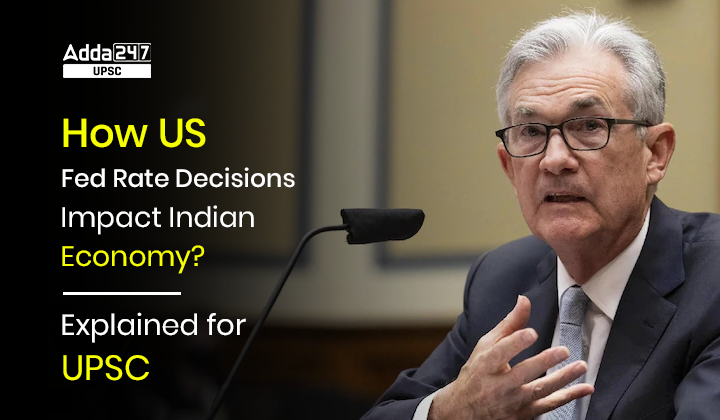Table of Contents
Relevance of US Fed Rate Decisions for UPSC
How US Fed Rate Decisions Impact Indian Economy?: US Fed Rate Hikes are continuously impacting Indian Economy and so the people of India. So, US Fed Rate Decisions & its Impact on Indian Economy are very important for both UPSC CSE Prelims and Mains Examination. For UPSC Mains, this covers, GS 3: Effect of policies and politics of developed and developing countries on India’s interests, Indian diaspora.
Fed Increase Interest Rate 2022: Highest Increase in Interest Rate Since 1994
What is the Issue?
- The US central bank has hiked interest rates again, and warned more rises will be necessary to rein in the rapid pace of price increases.
- The US Federal Reserve raised interest rates by half a percentage point on Wednesday and projected at least an additional 75 basis points of increases in borrowing costs by the end of 2023 as well as a rise in unemployment and a near stalling of economic growth.
Why India’s Fight Against Inflation Continues? | Today’s the Hindu Editorial Analysis for UPSC
What is the Federal Reserve Central Bank (The Fed)?
- The Federal Reserve, more commonly referred to as “The Fed,” is the central bank of the United States of America and is the supreme financial authority behind the world’s largest free-market economy.
- Because of the magnitude of the US’ influence on the global economy, ‘the Fed’ is considered one of the most influential financial institutions in the world.
- The Federal Reserve handles the monetary policies of the government independently and without legislative intervention.
- In addition to that, it performs all other functions of a central bank – regulating bank activities, conducting surveys about the US and global economy – all under the common objective of maintaining financial stability.
- The Federal Reserve is headquartered in Washington D.C.
Analysis Of Sansad TV Discussion: RBI’s Inflation Management Strategy
Why is the US Fed hiking interest rate?
- Due to factors like Covid-19 and the Ukraine war, in the US and some parts of Europe, inflation surged to multi-decade high levels.
- India, too, faced the heat as its retail inflation, measured in Consumer Price Index (CPI), has been above 6 percent, which is the top level of RBI’s tolerance band, for the last 10 months.
- So, the US Fed is hiking rates because it has to bring inflation down. Because when inflation rises, people have to shed more money for consumption. This erodes their purchasing power and hits demand which eventually hits production and economic growth.
- How Dangerous high inflation is?: High inflation leads to low purchasing power which leads to low consumption which leads to low demand which leads to lower production and lower economic growth. And the worst part is that this cycle repeats because a weak economy means weak production, low wages and so on.
- What IMF says?: “In an inflationary environment, unevenly rising prices inevitably reduce the purchasing power of some consumers, and this erosion of real income is the single biggest cost of inflation. Inflation can also distort purchasing power over time for recipients and payers of fixed interest rates.”
- So, Inflation is a big threat and it is Fed’s responsibility to keep inflation under permissible limits.
The Editorial Analysis- Making Sense of the Rupee Slump
Analysis Of Down To Earth Magazine: Rising Food Inflation Is A New Global Crisis!
What will be the impact of a more aggressive Fed rate action on Emerging Economies?
- After a rate hike by the US Fed, the difference between interest rates in the US and India shrinks which affects the currency trade negatively. The dollar and the US treasury yield become attractive in the US and the Indian market begins to see capital outflow.
- Moreover, the rupee gets weaker and it prompts rate hikes in India. If the rupee falls significantly, the RBI may be forced to sell some dollars to help the domestic currency. This depletes domestic forex reserve.
- The biggest shock for the market comes in the form of heavy selling by foreign investors. Usually, emerging markets give better returns than developed markets but when rates are raised, the magnitude of return becomes less attractive.
- In this scenario, foreign investors take money out of emerging markets like India and invest in US stocks which are relatively less volatile.
- A high rate signal by the Fed would also mean a lower impetus to growth in the US, which could be yet negative news for global growth, especially when China is reeling under the impact of a real estate crisis.
Rupee Depreciation in 2022: Indian Rupee at Record Low
FAQs on US Fed Rate Decisions & Its Impact Indian Economy
Q. What is the US Fed?
Ans. The Federal Reserve, more commonly referred to as “The Fed,” is the central bank of the United States of America and is the supreme financial authority behind the world’s largest free-market economy.
Q. How Dangerous high inflation is?
Ans. High inflation leads to low purchasing power which leads to low consumption which leads to low demand which leads to lower production and lower economic growth. And the worst part is that this cycle repeats because a weak economy means weak production, low wages and so on.
Also Read:




 TSPSC Group 1 Question Paper 2024, Downl...
TSPSC Group 1 Question Paper 2024, Downl...
 TSPSC Group 1 Answer key 2024 Out, Downl...
TSPSC Group 1 Answer key 2024 Out, Downl...
 UPSC Prelims 2024 Question Paper, Downlo...
UPSC Prelims 2024 Question Paper, Downlo...





